The fragrance wheel helps you create balanced DIY perfumes by organizing scents into four main families: Floral, Amber, Woody, and Fresh. You'll find complementary notes by looking at adjacent sections, while opposite sections create dynamic contrasts. Start with familiar scents like lavender (Floral) or bergamot (Fresh), then build your blend using top, middle, and base notes. The more you explore these aromatic relationships, the better you'll understand the art of perfume creation.
Understanding The Basic Structure Of The Fragrance Wheel
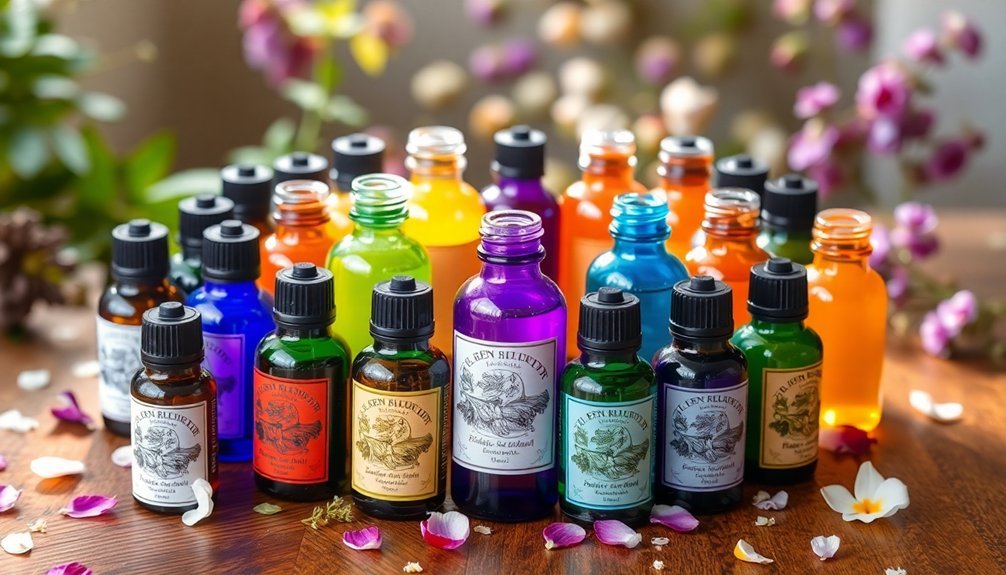
When diving into the world of DIY perfumery, the fragrance wheel serves as your essential roadmap to scent creation. You'll find four primary fragrance families: Floral, Amber, Woody, and Fresh, each containing unique fragrance subfamilies that define specific characteristics and traits.
As you explore the wheel's structure, you'll notice how adjacent scent notes naturally complement each other, making it easier to blend harmonious DIY perfumes.
The wheel's visual layout helps you identify complementary notes and understand how different families work together. You can use this knowledge to match fragrances with specific occasions and personal preferences.
Whether you're creating light, fresh combinations or deep, complex blends, the fragrance wheel guides your creative journey by revealing the intricate relationships between various scent families.
Essential Oil Families And Their Characteristics
Building on your understanding of the fragrance wheel, let's explore the specific families of essential oils that form the foundation of DIY perfumery. Each essential oil family brings unique characteristics to your fragrance creations.
You'll find that floral scent oils like lavender and rose deliver sweet, delicate aromas perfect for creating romantic, soothing blends.
Woody notes from sandalwood and cedarwood add warmth and stability to your compositions. For fresh fragrances, turn to citrus oils like lemon and bergamot, which provide energizing qualities that lift your mood.
Spicy notes from cinnamon and clove introduce warmth and complexity, while earthy varieties like patchouli and vetiver ground your blends with rich, deep undertones.
Understanding these essential oil families helps you create balanced, sophisticated perfumes that express your creative vision.
Top Notes, Middle Notes, And Base Notes Explained
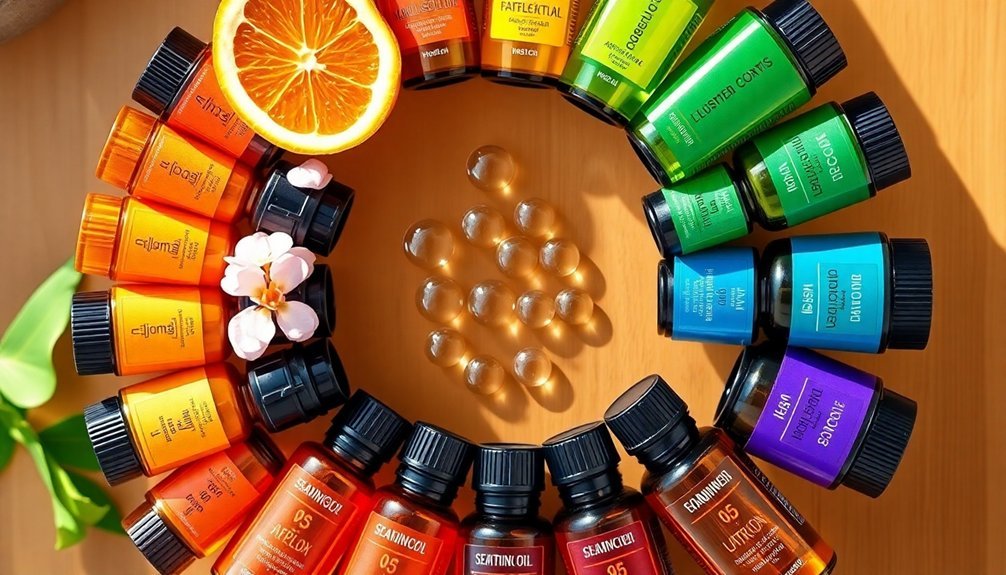
To create an enchanting perfume, you'll need to understand the three distinct layers that make up its structure: top notes, middle notes, and base notes.
These layers work together on the fragrance wheel to create a harmonious blend across different scent families.
Top notes are the first impressions you'll smell, featuring light, citrusy, or herbal aromas that last 15-30 minutes.
Middle notes, also called heart notes, emerge as top notes fade, delivering floral or fruity essences that persist for several hours.
Base notes form your fragrance's foundation with rich, deep aromas like vanilla, musk, or woods, lasting days and anchoring the entire composition.
When you're crafting your DIY perfume, consider how these different fragrances interact and evolve.
The right balance of notes guarantees your creation tells a complete olfactory story.
Blending Techniques For Harmonious Scent Creation
The art of blending fragrances requires a strategic approach to create enchanting scent combinations. When exploring blending techniques, you'll want to focus on how different fragrance families interact on the fragrance wheel.
Start by pairing complementary notes from opposite families, like combining Amber with Fresh scents for an intriguing contrast. You can also blend adjacent families, such as Floral with Fruity, to achieve harmonious compositions that share similar characteristics.
For more complex creations, try triad blends by selecting three fragrances that form a triangle on the wheel, creating a balanced and sophisticated profile.
Remember to take into account the strength of each note and how they'll interact across the top, middle, and base layers. This attention to detail guarantees your finished perfume will evolve beautifully over time.
Common Essential Oil Combinations That Work

When crafting your own perfume blends, you'll find that certain essential oil combinations naturally complement each other, like the classic pairing of lavender and bergamot for relaxation or peppermint and citrus for energy.
To create a balanced fragrance, start with a base note like cedarwood or patchouli, then layer in middle notes such as florals, and finish with bright top notes from the citrus family.
You can experiment with popular combinations like rose-geranium-patchouli or sandalwood-cinnamon-orange to discover your signature scent.
Popular Blend Recipes
Five timeless essential oil combinations have proven themselves as go-to blends for DIY perfume creators. As you explore the fragrance wheel, you'll discover how these essential oil blends complement each other perfectly for your desired effect.
| Blend Type | Oils | Effect |
|---|---|---|
| Calming | Lavender + Chamomile | Stress Relief |
| Energizing | Grapefruit + Bergamot | Mental Focus |
| Romantic | Rose + Ylang-ylang | Sweet Intimacy |
| Grounding | Cedarwood + Patchouli | Warm Balance |
These carefully curated combinations offer something for every scent preference. For relaxation, try the calming blend before bedtime. When you need an energy boost, reach for the citrus combination. Create romantic moments with floral blends, stay grounded with earthy scents, or embrace the warmth of spice-infused blends for a cozy atmosphere.
Balancing Base And Top
Creating lasting DIY perfumes requires mastering the delicate balance between base and top notes. When consulting your fragrance wheel, you'll find that citrus top notes like grapefruit pair exceptionally well with earthy base notes such as patchouli, creating a balanced scent that's both invigorating and grounded.
For a more romantic blend, try combining floral top notes like jasmine with sweet base notes such as amber. This combination delivers a rich, layered fragrance that evolves beautifully over time.
You'll also find success experimenting with complementary notes, such as minty top notes with warm, spicy base notes. Remember, while top notes provide the initial impression and fade quickly, base notes anchor your DIY perfumes and guarantee longevity.
The key is finding harmonious combinations that create depth and character.
Creating Your Signature Scent With The Wheel
The fragrance wheel serves as your essential map for understanding key scent families, from floral and woody to amber and fresh notes.
You'll discover powerful combinations by pairing opposite fragrances on the wheel, such as fresh citrus with warm oriental notes, or sweet florals with earthy woods.
Understanding Key Scent Families
When crafting your own signature scent, you'll need to navigate the fragrance wheel's four main families: Floral, Amber, Woody, and Fresh.
Each family offers distinct characteristics that'll help you create your perfect blend.
Floral scents dominate the perfume industry with their romantic notes of jasmine and rose, while amber fragrances deliver warm, spicy elements through vanilla and cinnamon.
You'll find woody scents provide depth through earthy notes like sandalwood and cedar, often working beautifully when balanced with lighter elements.
Fresh fragrances bring vibrant energy through citrus, oceanic, and herbal components, making them perfect for daytime wear.
Understanding these scent families allows you to experiment with complementary notes and create harmonious combinations.
You can blend across families to develop unique fragrance profiles that reflect your personal style.
Blending Opposite Fragrances Well
Learning to blend opposite fragrances from the fragrance wheel reveals endless possibilities for your signature scent.
You'll discover intriguing combinations by pairing complementary notes that sit across from each other, like combining warm Amber with Fresh notes or rich Vanilla with zesty Lemon.
When blending opposite fragrances, consider the intensity of each component.
Try pairing a strong Oud with lighter Bergamot, or experiment with layering by using Jasmine to soften Cedarwood's impact.
Your personal olfactory preference plays a vital role in creating unique scents that reflect your style.
Don't be afraid to test different combinations.
The fragrance wheel serves as your guide, but your creativity determines the final blend.
Remember that opposite scents can create surprisingly harmonious results when balanced thoughtfully.
Following Fragrance Wheel Rules
Creating your signature scent starts with mastering the fragrance wheel's fundamental rules.
Begin by choosing a primary fragrance family that matches your style preferences, whether it's floral, woody, amber, or fresh.
When blending, look to adjacent notes on the fragrance wheel for harmonious combinations that naturally complement each other. For added depth, incorporate complementary notes from opposite sides of the wheel to create intriguing contrasts.
Structure your blend with top notes for initial impact, middle notes for the heart of the scent, and base notes for lasting power.
Keep detailed records of your blending experiments, noting which combinations work best. This documentation will help you refine your technique and develop a truly unique signature scent that perfectly captures your personality.
Fragrance Wheel Tips For Beginners
The fragrance wheel serves as your essential roadmap for DIY perfume creation. Start by familiarizing yourself with the four main families: floral, fresh notes, amber and woody scents.
These fundamental categories will help you understand how different aromas interact and complement each other.
When you're ready to blend, choose scents from adjacent families for harmonious combinations, or experiment with opposite families for more dynamic results.
Build your collection gradually, starting with a few essential oils from each category. As you create your DIY perfumes, remember to layer your fragrances strategically – begin with top notes, followed by middle notes, and finish with base notes for depth and longevity.
Don't forget to label and track your successful combinations using the fragrance wheel as your reference guide.
Seasonal Perfume Blending Guidelines
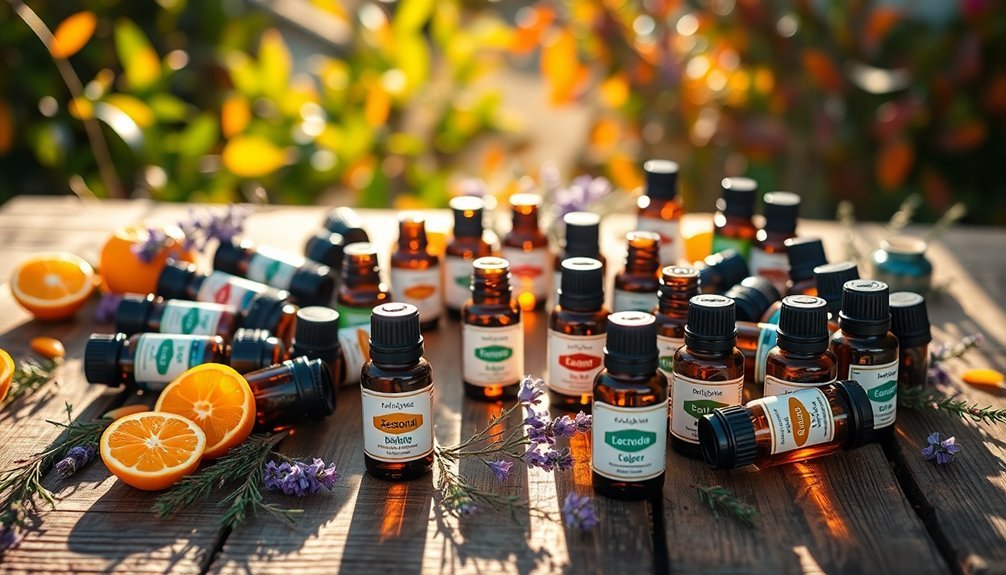
As seasons shift throughout the year, your perfume blending strategy should adapt to capture nature's changing moods.
Your seasonal perfume blending approach should embrace lighter notes during warmer months and richer aromas in cooler seasons.
For spring, combine soft floral and green notes to create an uplifting blend that mirrors new growth.
In summer, mix citrus scents with aquatic elements for a revitalizing impact.
When autumn arrives, incorporate woody notes and spicy undertones like cinnamon and clove to reflect the season's warmth.
Winter calls for deeper, more intense fragrances – try blending vanilla, musk, and resinous elements for a cozy atmosphere.
Remember to reflect on each season's emotional qualities when creating your blends.
This mindful approach guarantees your perfumes resonate with both the weather and your wearer's mood.
Safety And Storage Considerations For DIY Perfumes
When making your own perfumes, prioritizing safety and proper storage practices guarantees both your well-being and the longevity of your fragrances.
Before applying your DIY perfumes, you'll need to conduct a patch test on a small area of skin to identify potential allergic reactions or sensitivities.
Store your essential oils and DIY perfumes in dark glass bottles, keeping them in a cool, dry place away from sunlight and heat sources.
You'll want to label each bottle with the creation date and ingredient list to track shelf life effectively.
Be particularly careful with phototoxic essential oils, especially citrus-based ones, as they can cause skin reactions when exposed to sunlight.
These safety measures, combined with proper storage techniques, will help maintain your perfumes' quality while protecting your skin from adverse reactions.
Frequently Asked Questions
What Is the 30/50/20 Rule for Perfume?
You'll create balanced perfumes by following the 30/50/20 rule: use 30% top notes for initial scent, 50% middle notes for the core fragrance, and 20% base notes for lasting depth.
What Is the Formula for Making Perfume?
You'll need 15-30% fragrance oils mixed with 70-85% alcohol or carrier oil. Follow the 30/50/20 rule: combine top notes (30%), middle notes (50%), and base notes (20%) for balanced perfume.
How to Read a Fragrance Wheel?
Start at the wheel's center with main families (Floral, Amber, Woody, Fresh). Move outward to explore subfamilies. You'll find similar scents placed next to each other, while opposite scents create interesting contrasts.
What Is the Ratio of Fragrance Oil to Perfumers Alcohol?
You'll want to use 20-30% fragrance oil with 70-80% alcohol for Eau de Parfum, 5-15% for Eau de Toilette, or 2-4% for Eau de Cologne. These ratios determine your perfume's strength and longevity.
In Summary
You're now equipped to create unique DIY perfumes using the fragrance wheel as your guide. Take what you've learned about note layering, essential oil families, and proven combinations to experiment confidently. Remember to follow safety guidelines, store your creations properly, and trust your nose. Start with simple blends and gradually work your way to more complex compositions. Your perfect signature scent awaits!
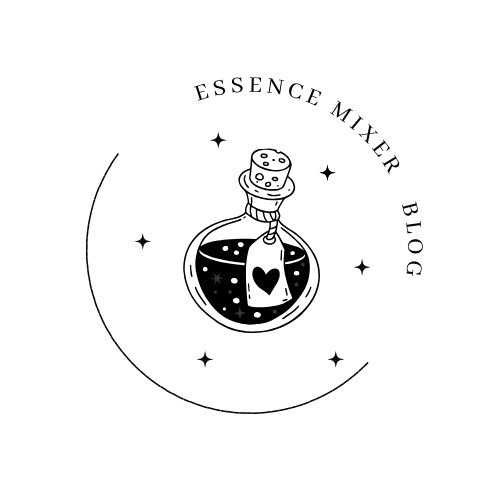
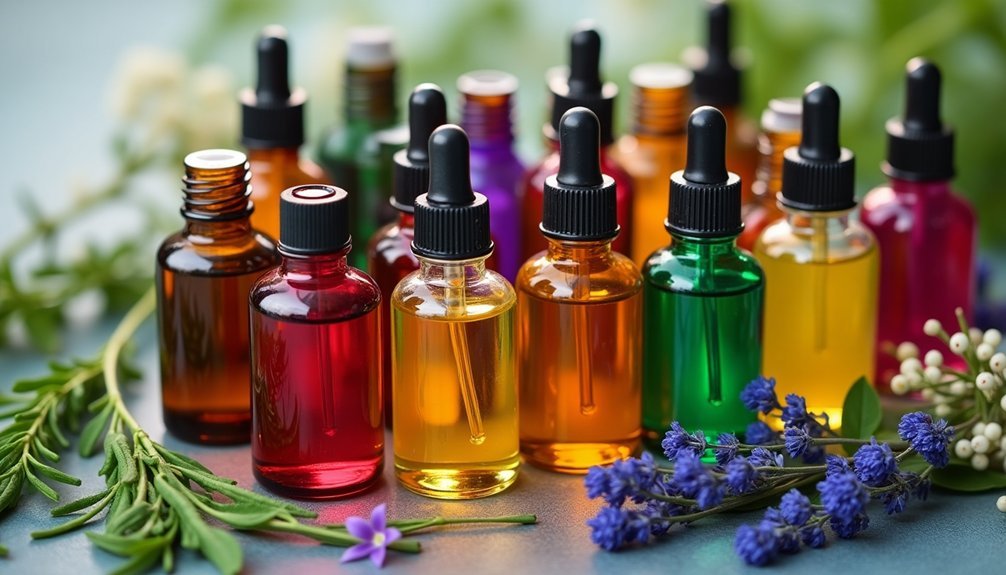
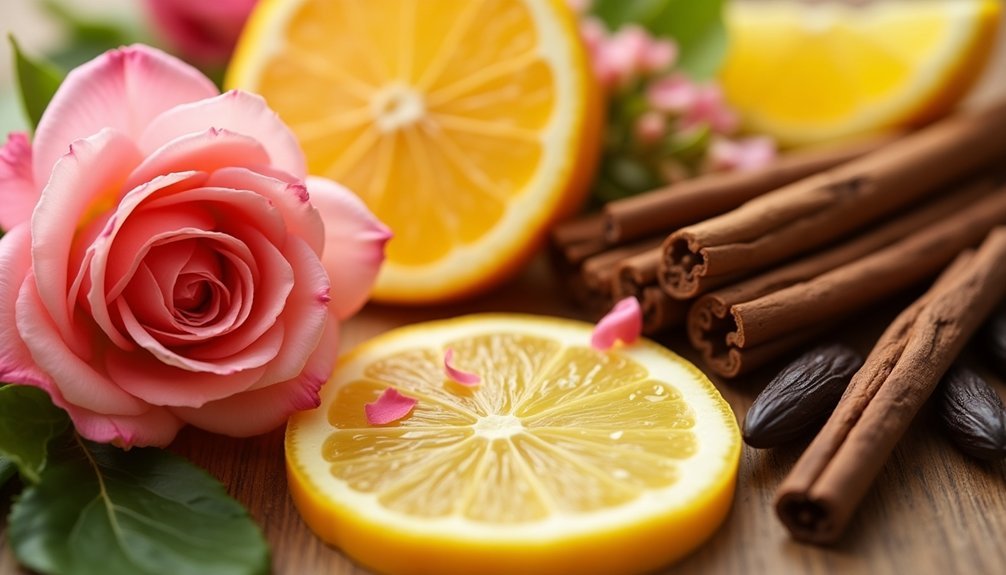
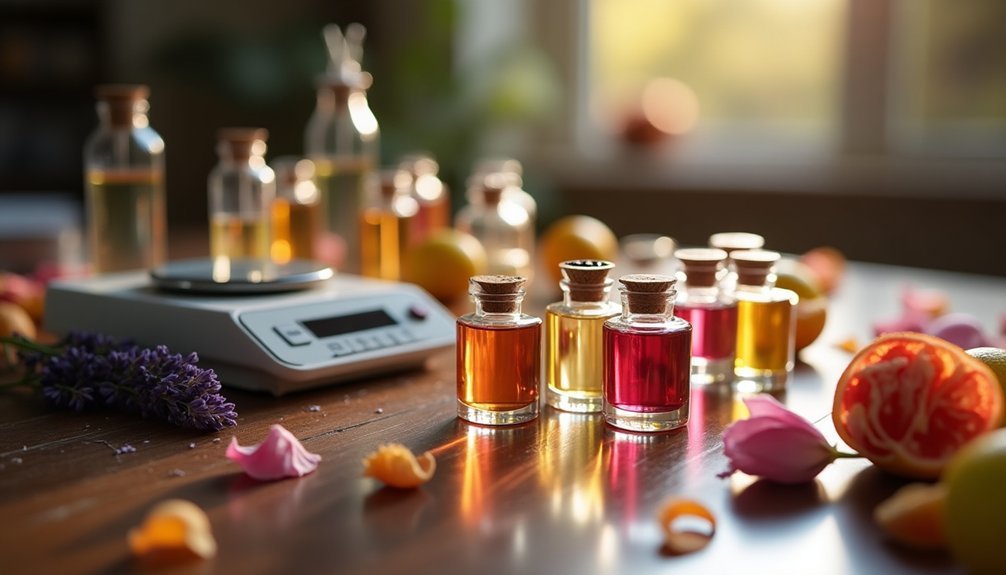
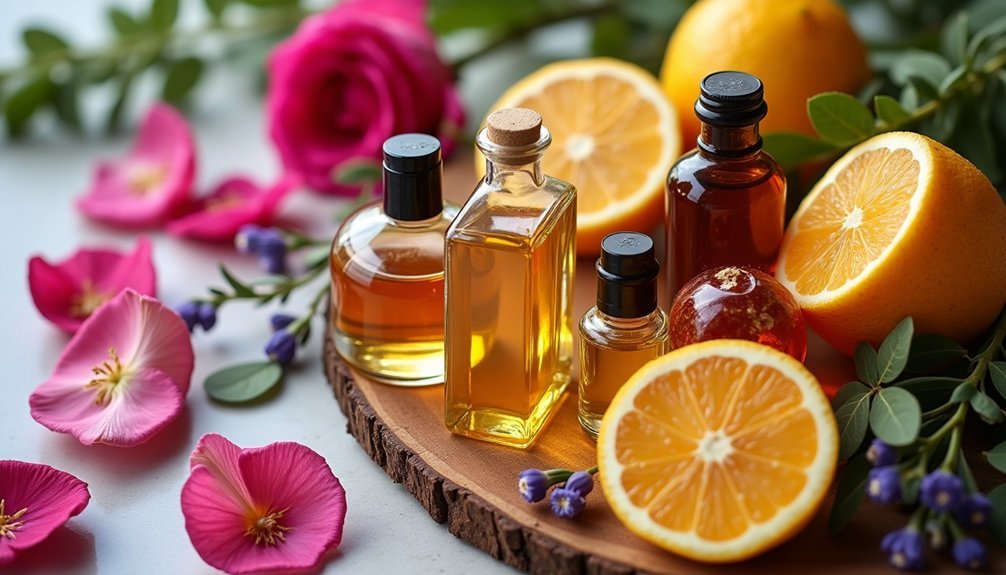
Leave a Reply